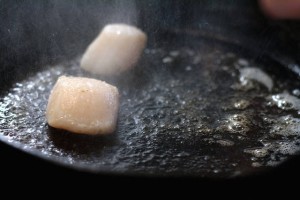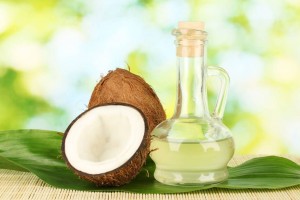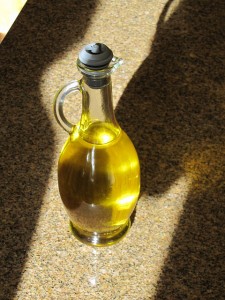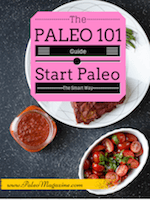What Everybody Ought to Know About Fats – 7 Mistakes that Can Sabotage Your Health
 How scared of your food are you?
How scared of your food are you?
Do you worry – when you walk through the grocery store or when you eat at a restaurant – that the foods you buy might make you or your family fat or sick?
I’m tired. I’m tired of having to worry about what I eat. Tired of being told that something else will cause cancer. Tired of being scared.
I think that you might be tired, too, so I propose that we stop being afraid.
We shouldn’t throw caution to the wind – we have bodies and families to care for, after all. But we should learn from the mistakes that we’ve made and eat without fear.
I propose that we start by coming to grips with these 7 mistakes about fats…
MISTAKE #1: Fat in our Food = Fat in our Body
It’s sad that fat in food is called “fat” at all.
When we use that word, it’s so easy to imagine the fat going from our mouth straight to the fat around our stomach or legs.

However, the fat in our food and the fat around our stomachs are not the same.
Body Fat is energy that is stored in fat cells in our bodies. No matter how skinny someone is, they always have some body fat. I could list a hundred different reasons that bodyfat is important, but above all else, body fat is a source of energy, and you would die without it. When you eat, some of the energy from your food goes directly into your bloodstream. However, you’re going to need energy for quite a while after you eat, so your body conveniently stores most of the energy from your food, and the primary way that your body stores energy is in fat.
Most importantly, body fat can be created from fat, protein, carbs, or even alcohol.
Fats are also used in your body for other functions, such as building the walls of your cells, so much of the fat you eat will be used for things other than just making you look or feel fat.
Dietary Fat is the fat that is contained in the food you eat. It may eventually become body fat, or it may be used in your body in another way. However, it’s not the same as body fat – not yet. And it’s important to differentiate dietary fat because there are different types of dietary fat and functions that it plays before it’s fully absorbed.
LESSON #1: The fat we eat is not the same as the fat on our tummies.
As a brief intermission, here is a video I put together on 3 of these 7 mistakes:
MISTAKE #2: You Don’t NEED to Eat Fat
To put it bluntly, this mistake is simply wrong. Just like every other animal, humans need to eat fat.
Even animals that eat low-fat foods actually have high-fat diets. (Stick with me here.) The food that goes into the mouth of a cow or a gorilla is low in fat. However, once that food is inside the digestive tract of a gorilla or cow (both substantially different than a human digestive tract), the fiber and cellulose in the plant matter is fermented into fat.

In other words, although many animals put low-fat food into their mouths, one way or another, they end up absorbing a lot of fat.
You and I (humans), on the other hand, don’t have the same capability to ferment fiber and cellulose in our guts, so we’re stuck needing to eat foods that are already high in fat. If you’re interested in human evolution, then it’s interesting to know that our ancestors first started developing larger brains when they were able to readily find sources of fat, such as they might have done by scavenging the brains and marrow of dead animals (before they became smart enough to become great hunters).
As it stands now, our brains use up a huge portion of our overall energy, which wouldn’t be possible without readily available sources of fat.
LESSON #2: You and I can’t produce fat in our gut, so we need to eat it.
MISTAKE #3: You Can Absorb Vitamins Without Fat
It’s actually impossible to absorb certain vitamins unless they’re eaten with fat.
Vitamins like A, D, E, and K need to be eaten with fat in order to be properly absorbed by our bodies.
Without going too much into the science, fats are broken down into smaller particles in our stomachs and intestines, and the fat-soluble vitamins are able to attach to these smaller particles and be carried through our intestinal walls into our bloodstreams. Without the presence of fat, these vitamins generally pass right through.
As a plus, these are not vitamins that generally need to be obtained every day, because they’re stored along with fat in our bodies, but they do still need to be obtained semi-regularly, so avoiding fat is a problem in that respect.
LESSON #3: When you don’t eat enough fat, you’re also missing out on a bunch of important vitamins.
MISTAKE #4: We Should Avoid Fat Because It’s High in Calories

Technically, fat is higher in calories than either protein or carbs. Surely that makes it more fattening?
Actually, our bodies are smarter than we give them credit for.
On the one hand, fat makes us full much more quickly, meaning that we end up eating less overall.
Secondly, how many calories we take in actually changes the number of calories we burn, particularly if we’re eating high-quality, nutrient-dense, Paleo foods.
LESSON #4: Our bodies are cool like that and know how to adjust to fats in our food.
MISTAKE #5: Our Bodies Can Produce All the Fat We Need
It’s true that our bodies can produce fat.
But our bodies can only do so much.
Because fats are also used as building-blocks in our bodies, we need to eat certain types of fats that our bodies can’t produce.
In general, our bodies can produce some types of fats, either from other types of fats or from other macro-nutrients, like carbs or alcohol. However, that’s not possible for all types of fats, including a few of the much-touted Omega-3 fats like DHA and EPA. Our bodies can produce very small amounts of these fats, but not much, and these fats play a variety of roles in our bodies.
LESSON #5: We MUST get certain types of fat from our foods.
MISTAKE #6: All Fats are Created Equal
And here we get to the crux of the matter…
When you read the nutritional label on a food, there are only 3 things that must be listed (at least in the United States) about fat: (a) total fat, (b) saturated fat, and (c) trans-fats.
In reality, though, there are several other types of fats (mono-unsaturated, poly-unsaturated, interesterified, etc.), and food manufacturers are not required to list those types of fats.
More importantly, it is critically important that you eat and cook with the right type of fats. Some fats will fuel and nourish your body, while other fats will break and poison it.
LESSON #6: Know your fats, read your labels, and eat the right fats.
SUPPLEMENT TO MISTAKE #6: The Types of Fats
Because there is so much conflicting information out there about the different types of fat, here is a quick and easy summary of each type of fat:
SATURATED FAT
Oh…saturated fat – so wrongly accused and vilified for so long.
Saturated fats are a group of fats that can be broken down into subgroups (long-chain saturated fats, medium-chain triglycerides) as well as individual fats (palmitic acid, stearic acid, lauric acid, etc.). Here’s what you really need to know about saturated fats:
1. As Paul Jauminet has noted in his book The Perfect Health Diet, bodyfat is actually stored and released primarily as saturated fat. This means that your body prefers to burn saturated fats.
2. There is no known toxicity level for saturated fat. This means that when you burn saturated fat, no toxic by-products are released (unlike certain other fats and carbohydrates).
3. Saturated fats play structural roles in the human body, such as forming part of cell membranes.
4. Saturated fat is extremely stable. Because of its chemical properties, saturated fat does not oxidize very easily. This is extremely important because oxidation of fats is what makes them rancid and also one of many factors that contributes to cardio-vascular disease.

Long story short, most of the fats you eat should be saturated fats. Primarily because they’re the most stable and non-toxic of fats, they are also generally the safest and easiest to cook with. They play super-important roles in the human body and are the form of fat that our body relies on from its own stores of fat.
Saturated fats are found lots of places, but 2 of the primary places that you’ll find saturated fat in a Paleo diet is in animal fats and coconut oil.
If you’re still worried about saturated fats based on decades of propaganda, then I urge you to check out Chris Kresser’s series on Heart Disease.
MONOUNSATURATED FAT
Like saturated fat, monounsaturated fats are very safe to eat in large amounts because they are also very low in toxicity.
As an aside, toxicity and stability are really the 2 most important factors when it comes to fats. If a fat is toxic, it means that it’s going to release certain harmful toxins into your body when that fat is burned inside your body. To a degree, a few toxins are not going to be a problem, but limiting them is always a good idea. In terms of stability (which is related to toxicity), some fats are more likely than others to be damaged by exposure to heat, oxygen, or light. When this happens – particularly inside your body – this process releases free radicals that can damage tissues inside your body and increase the risk for diseases like cancer and cardiovascular disease.

Monounsaturated fats are found in a lot of animal fats, but also in avocado, olive oil, peanut oil, and numerous other plant-based oils. Unfortunately, as I’ll explain below, many of the plant sources of monounsaturated fats are actually much higher in Omega-6 fats that should be minimized.
Monounsaturated fat facts:
1. Like saturated fats, monounsaturated fats do a lot of work forming structural parts of our bodies’ cells.
2. Also like saturated fats, they are very non-toxic, even in large doses.
3. In terms of stability, monounsaturated fats are more stable than some fats (polyunsaturated) but less stable than others (saturated), meaning that they’re still pretty safe to cook with, but not as safe as saturated fats.
Along with saturated fats, monounsaturated fats should form the majority of the fat you eat.
And this is made easy by the fact that many of the most common animal sources of fat (pigs and cows) is a mixture mostly of saturated and monounsaturated fats. These sources also have polyunsaturated fats, but in much lesser amounts.
POLYUNSATURATED FAT
You’re probably more familiar with polyunsaturated fats by the names “Omega-3” and “Omega-6,” which are each a sub-group of polyunsaturated fats.
Facts:
1. Both Omega-3 and Omega-6 fats are “essential.” Being essential means that our body has a very limited ability to produce these fats, so we need to eat them. We don’t need to eat very much, but we do need to eat some.
2. Both Omega-3 and Omega-6 fats are highly unstable, meaning that they can be damaged very easily. As noted above, once damaged, they release free radicals that can cause inflammation and generally damage tissue inside of our bodies, increasing the risk of various diseases.
3. Here’s the most confusing part. Ideally, humans would eat just enough (not very much) Omega-3 and Omega-6 fats. However, it’s even more important to make sure that you’re eating a good ratio of Omega-3 and Omega-6 fats. The primary problem in our modern diets is that we often eat a huge amount of Omega-6 fats and not very much Omega-3 fats. While minimizing both would be optimal, if you’re going to eat a lot of Omega-6 fats, then you also need to increase the amount of Omega-3 fats you’re eating.
4. Some types of Omega-3 fats are better (and more essential than others). In general, most of the Omega-3 you should be eating is known as EPA and DHA. These types of Omega-3 fats are found mostly in seafood and animals. Plant sources of Omega-3 fats (such as flax) are known as ALA, which your body has a hard time converting to DHA and EPA.
Polyunsaturated fats have a mixed reputation within the mainstream healthy community. Almost everyone believes that we should eat more Omega-3 fats in order to balance out the ratio between Omega-6 and Omega-3 fats. What’s not often stated is that it would generally be better for us to balance that ratio by reducing the amount of Omega-6 fats that we eat.
As noted above, we as humans need to eat some polyunsaturated fats, but we don’t need a whole lot. Chris Kresser recommends eating no more than 4% of your total calories from polyunsaturated fats.
Omega-3 fats are found mostly in animals and particularly in seafood. Omega-6 fats are found in a wide variety of foods, but they’re particularly high in vegetable oils, grains, and nuts. Even meats contain Omega-6 fats, with white meat like chicken having a higher percentage.
TRANS-FATS
Even more so than saturated fats, trans fats have a horrific reputation. And that’s mostly deserved, but there’s a slight twist.
Most trans-fats are created artificially through a process known as “hydrogenation,” which literally changes the chemical structure of natural fats in order to make them more shelf-stable so that food manufacturers can keep their products on the shelves for long. It’s one of many reasons that so many processed foods can last for years longer than most natural, whole foods.
These artificial trans-fats have been linked to an increased risk of heart disease, diabetes (also here), weight gain, Alzheimers, and a slew of other diseases.
There are no facts here, other than that trans-fats created through the hydrogenation process are terrible for you.
The twist is that there are actually naturally-occurring trans-fats. These naturally-occurring versions are actually beneficial for humans in many ways and don’t seem to have the same downsides as artificially-produced trans-fats.

As you’ve probably guessed, it’s essential that you avoid artificial trans-fats as much as possible. They’re generally found only in processed foods, such as potato chips, donuts, bread, etc.
Because there has been a huge public backlash against trans-fats, most food manufacturers now avoid putting them in their products. But the question you should ask yourself is what do they put in instead? Here’s the answer…
INTERESTERIFIED FATS
For the most part, almost nobody has heard of interesterified fats. However, this is the class of fat that you should be most concerned with. (Yes – even more so than trans-fats).
Interesterified fats are created through a process that is generally the same one used to create trans-fats. Consequently, they last a very long time on the shelf just like trans-fats. And luckily for the food manufacturers, they’re not required to label them as trans-fats really at all.
For you and me, though, this is a huge problem. Research has started to show that these interesterified fats are at least as bad and probably worse than trans-fats. And this is no surprise. Since they’re created through a hydrogenation process that is very similar to trans-fats, we’d expect interesterified fats to be no better for us.
Interesterified fats are found in many processed foods – generally the foods that used to use trans-fats – like potato chips, bread, donuts, cookies, etc.
MISTAKE #7: Fats are Scary
Chemicals, Pesticides, Carcinogens, GMOs. There are many things to be scared of in foods.
But why fats?
The way that fats have been treated and discussed in the United States for the past 50 or so years is an absolute shame.
And as you are probably aware by now, fats are not the evil health problem that we’ve been told about for so long.
Fats form an essential, necessary, and beneficial part of our diet. They have done so for the entirety of human history, and it was access to fatty sources of food that actually allowed us to develop larger brains and become human.
Consequently, fat is something that is a part of our food that should be celebrated and enjoyed.
Fats from animals, seafood, avocados, coconuts, and a variety of other real, whole foods provide us with nutritious sources of energy. Fats from processed junk like donuts, bread, and potato chips do not.
LESSON #7: Let go of the fear and rejoice.
UPCOMING
The biggest source of fats in our diets is from the oils that we cook with. Consequently, I have a post and video in the works about choosing the healthiest and most Paleo cooking oils.
In the meantime, here’s what I need from you:
Please tell me in the comments below your favorite sources of fats. Also, I really want to hear stories about fats, how you overcame your fear of fats, or incidents when someone naively tried to warn you about how much fat you were eating. Also, please let me know if you have any questions about fat!
Images (in order): Nomadic Lass, IntelGuy, mrflip, jypsygen, ConanTheLibrarian, and vnysia.

